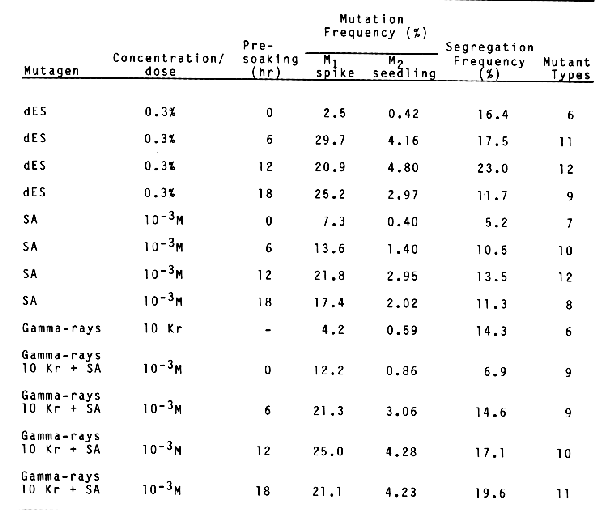

Possibility of isolation of beneficial mutants increases when higher frequency and wider spectrum of mutation are induced. Mutation frequency and spectrum can be altered by various methods such as post-treatment storage, combining different mutagens and applying mutagen at the particular time of the cell cycle (Nilan 1973, Sideris et al. 1973, Nilan et al. 1975, Khalitkar and Bhatia 1975, Kamra and Bunner 1977). In the present experiment, mutations were induced in an Indian 6-row hulled barley cultivar DL 36, using gamma-rays (10 Kr), sodium azide (10-3M) and diethylsulphate (0.3%). In the treatments with the chemical mutagens, presoaking of seeds in distilled water was done for 0, 6, 12 and 18 hours. Mutagenic treatments were done for 2 hours in the laboratory at 20°C. Chlorophyll mutants (chlorophyll-deficient seedlings) were scored in M2 generation in the field conditions.
The mutation frequency (MF) induced by gamma-rays was 4.2% on M1 spike basis and 0.59% on M2 seedling basis (Table 1). Sodium azide (SA) induced mutation with a frequency of 7.3% (M1 spike) and 0.40% (M2 seedling) in non-presoaked seeds. When gamma-rays and SA were combined, MF was found to be increased and the effects seemed to be additive on M1 spike basis and synergistic on M2 seedling basis. The maximum MF in the combined treatment was observed in 12 hour presoaking (25.0% M1 spike; 4.28% M2 seedling). In the presoaked seed treatments, increased MF was observed. It was the highest in 12 hour presoaking duration in all the mutagenic treatments. Diethylsulphate caused much sterility and reduction in the number of seedlings per spike resulting in higher MF as compared to SA. The amount of fertility and the MF were found to be associated negatively. Segregation frequency was 14.3% in gamma-rays, and it ranged from 5.2 to 13.5% in SA, 11.7 to 23.0% in dES and 6.9 to 19.6% in gamma-rays + SA treatments (Table 1).

As compared to single treatments of SA or gamma-rays, the mutant spectrum induced by the combined treatment was wider. Presoaking of seeds also induced wider mutant spectrum than dry seed treatments. Combined mutant types such as alboviridis and virido-albina were observed mostly in presoaked and combined treatments. Albino seedlings with dark pink transverse bands on leaves were observed only in dES treatment of 6 hour presoaked seeds, the frequency being 4.8%. Frequencies of different types of mutants varied in different mutagens. Overall frequencies of albina, viridis and xantha mutants were 26.0, 34.5 and 9.1%, respectively in dES, 32.3, 25.8, and 9.4%, respectively in SA, 45.2, 12.9 and 3.2%, respectively in gamma-rays and 27.8, 26.5 and 11.8% respectively in the combined treatments of gamma-rays and SA.
References:
Kamra, 0. P. and Brunner, H. 1977. Chemical mutagens: mode of action, pp. 59-65. In: Manual on Mutation Breeding, 2nd Ed., Tech. Report Series No. 119, FAO/IAEA, Vienna.
Khalitkar, A. S. and Bhatia, C. R. 1975. Synergistic effect of combined treatments of gamma-radiation and ethyl- methane-sulfonate in barley. Radiation Bot. 15:223-229.
Nilan, R. A. 1973. Increasing the effectiveness, efficiency and specificity of mutation induction in flowering plants, pp. 205-222. In: Genes, Enzymes and Populations. Ed. A. Srb., Plenum Publ. Corp.
Nilan, R. A., Kleinhofs, A. and Sander, C. 1975. Azide mutagenesis in barley. Barley Genet. 111: 113-122.
Sideris, E. G., Nilan, R. A. and Bogyo, T. P. 1973. Differential effect of sodium azide on the frequency of radiation-induced chromosome aberrations vs. the frequency of radiation-induced chlorophyll mutations in Hordeum vulgare. Radiation Bot. 13:315-322.